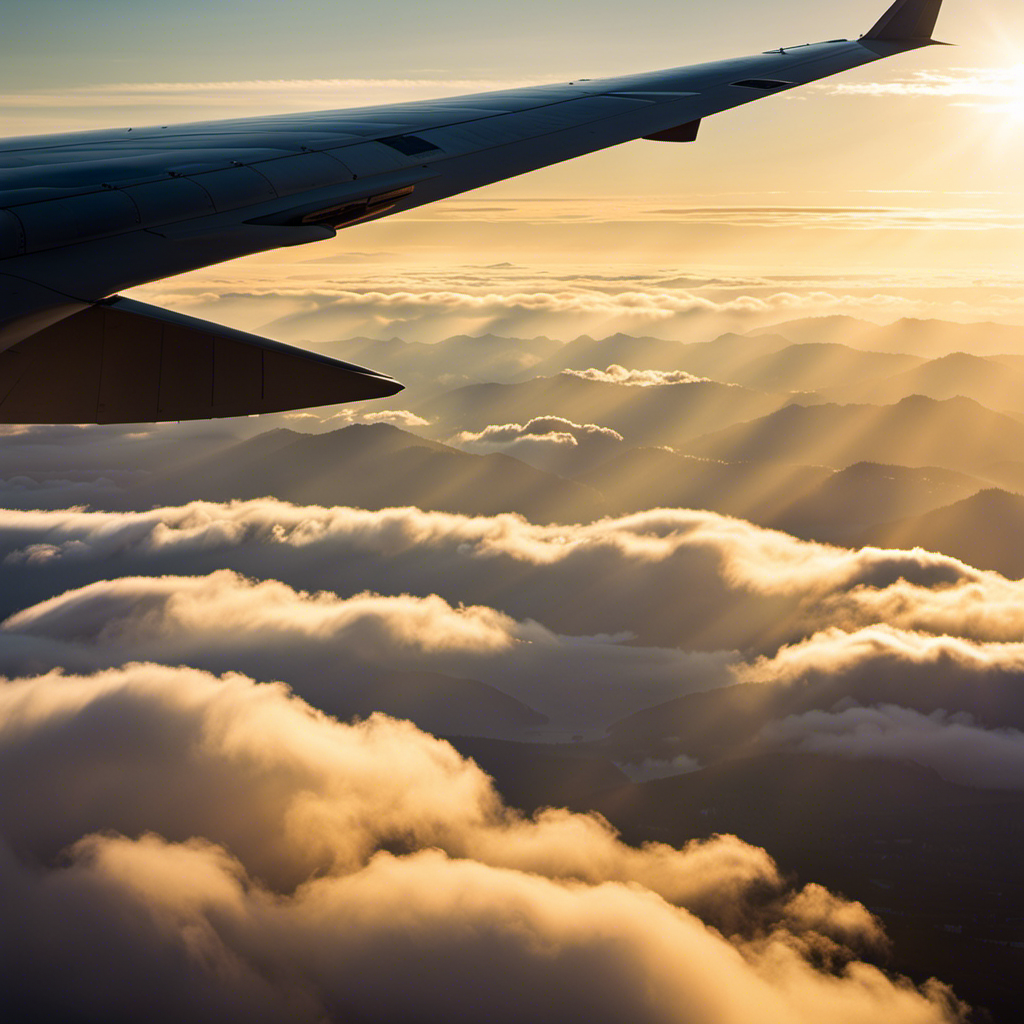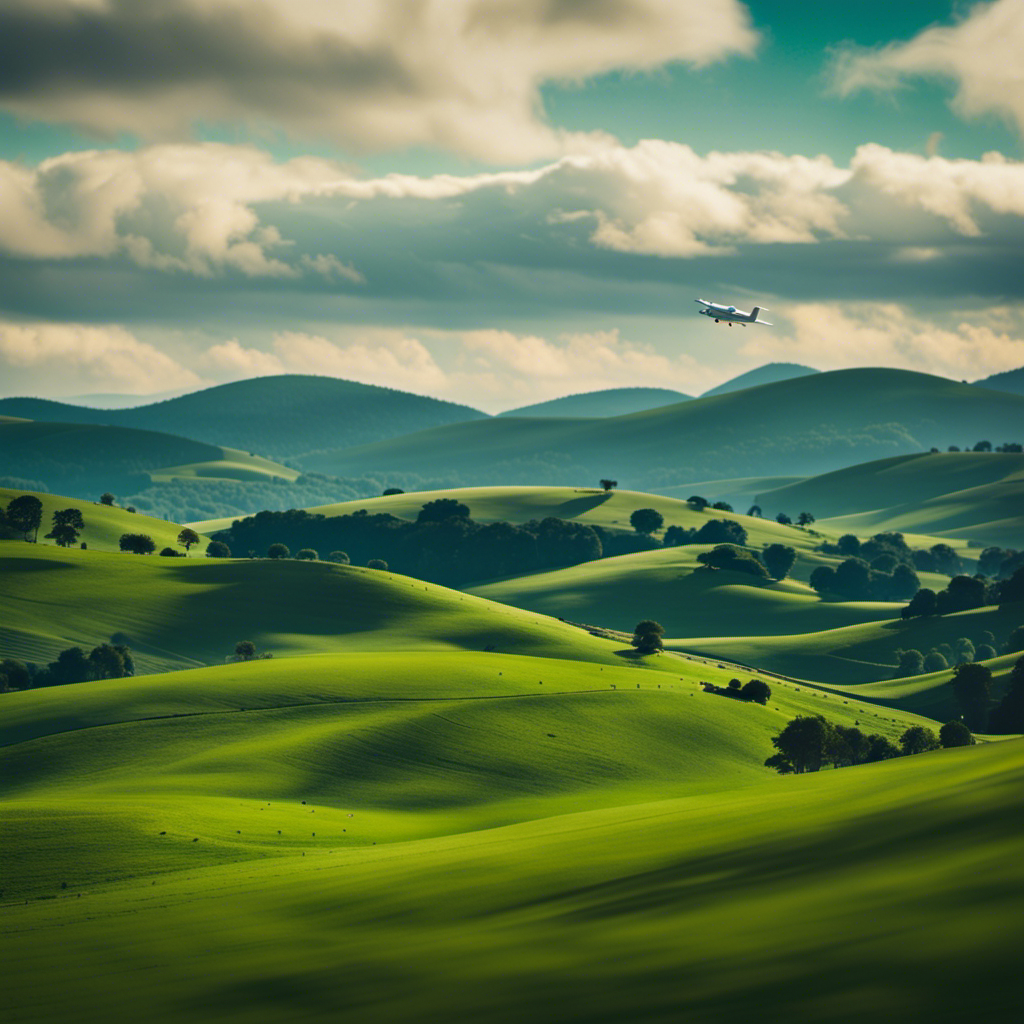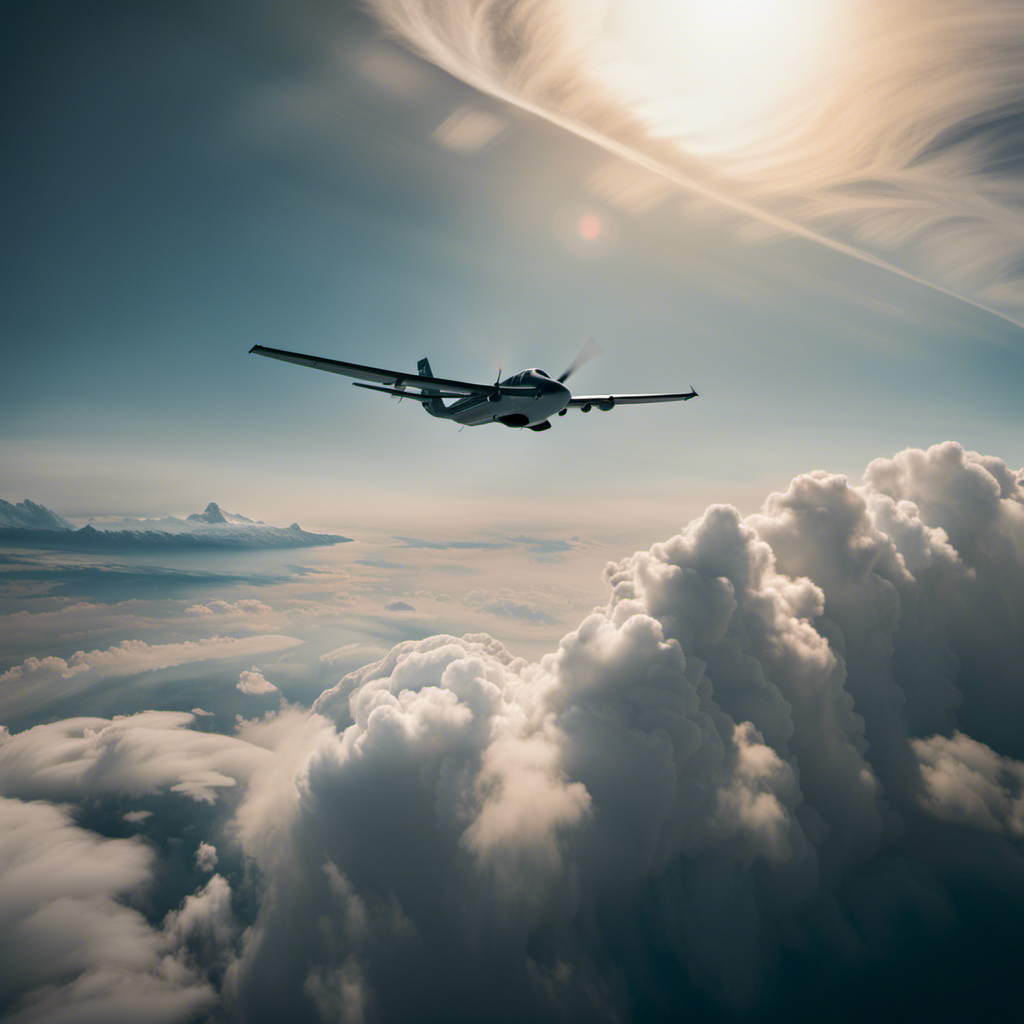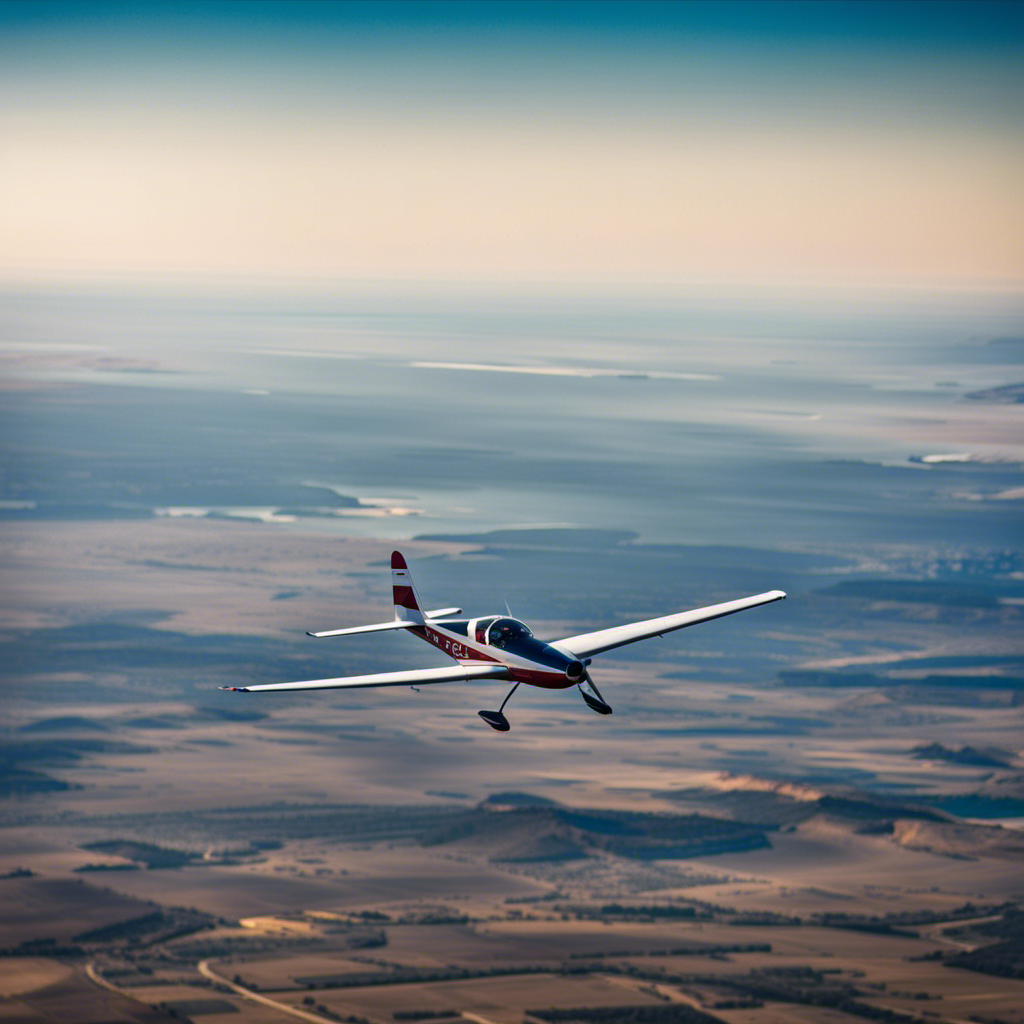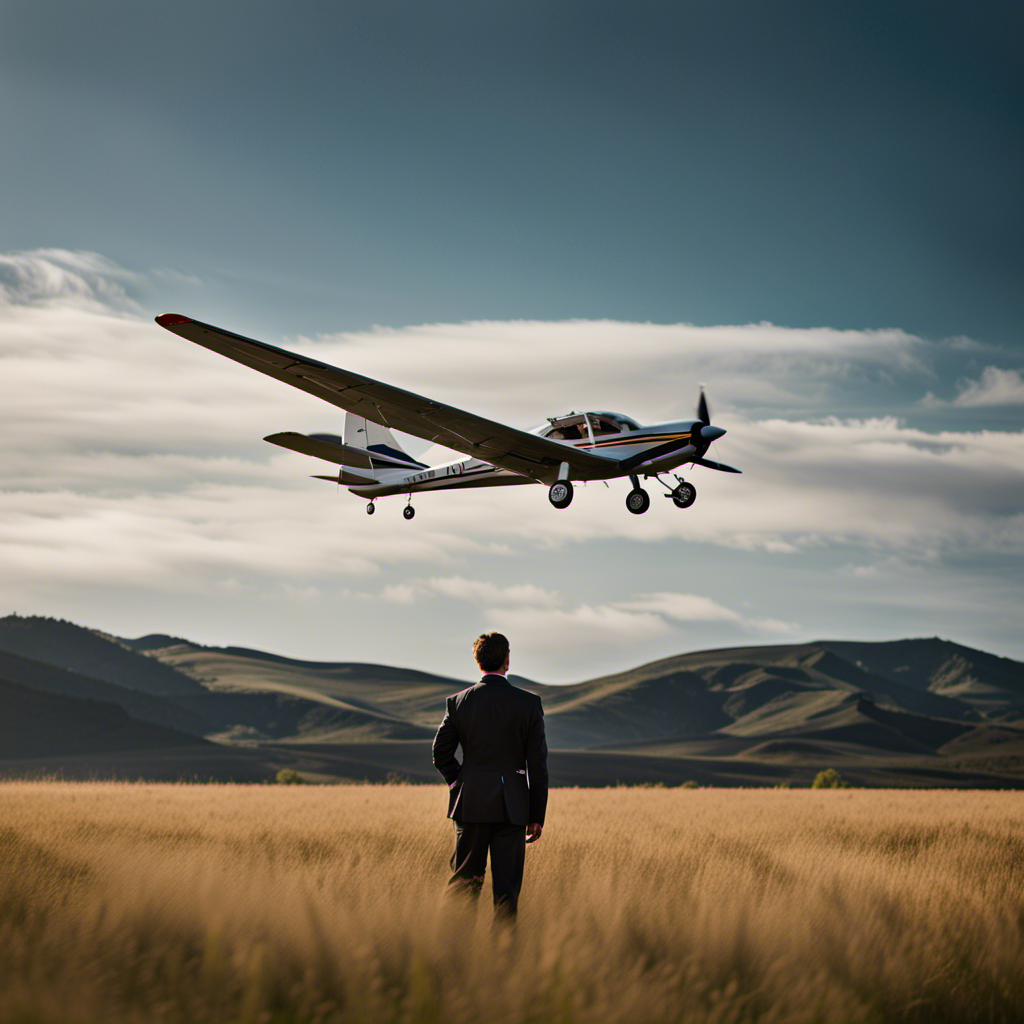As a glider pilot, I have always been fascinated by the question of how high we can fly in these graceful aircraft.
Today, we embark on a journey to explore the glider altitude record and the incredible achievements of those who have pushed the boundaries of flight.
From the earliest days of glider flight to the cutting-edge technology of today, we’ll delve into the history, science, and challenges of reaching new heights.
So buckle up and prepare to be amazed by the remarkable world of glider altitude records.
Key Takeaways
- Glider flight has a rich history, with pioneers like Otto Lilienthal and Octave Chanute contributing to the evolution of glider design.
- Factors such as lift generation, thermals, updrafts, ridge lift, and wave lift play crucial roles in achieving altitude in glider flight.
- High-altitude gliding presents challenges such as thin air, decreased oxygen levels, extreme temperatures, and strong winds, which impact both the glider and the pilot.
- Notable records in glider altitude include highest altitude reached, longest duration flight, fastest speed, and highest climb rate, showcasing the dedication, skill, and innovation in the field.
The History of Glider Flight
You can learn about the history of glider flight by studying the achievements of early aviators. The evolution of glider design can be traced back to the 19th century, when pioneers like Otto Lilienthal and Octave Chanute made significant contributions.
Lilienthal, often referred to as the ‘father of gliding,’ conducted extensive research on aerodynamics and developed a series of glider designs based on his findings. His work laid the foundation for future advancements in glider technology.
Another famous glider pilot from history is Orville Wright, one half of the Wright brothers who made the first powered flight. Before their powered flight, the Wright brothers extensively experimented with gliders to perfect their understanding of flight dynamics.
These early aviators not only pushed the boundaries of glider design but also paved the way for the science behind glider flight. Understanding their achievements and contributions allows us to appreciate the science and engineering principles that govern glider flight.
The Science Behind Glider Flight
Understanding lift and aerodynamics is crucial for successful glider flight. By comprehending the principles of lift, pilots can manipulate the airflow over the wings to generate upward force and sustain flight.
Additionally, utilizing thermals and updrafts is a valuable strategy for glider pilots. These natural phenomena provide upward vertical air currents that can extend their flight time.
Lastly, navigating different weather conditions is a skill that glider pilots must master. Wind patterns, cloud formations, and atmospheric conditions can greatly impact their flight performance and safety.
Understanding lift and aerodynamics
To maximize your glider’s altitude, it’s crucial to grasp the principles of lift and aerodynamics. Lift mechanics and aerodynamic principles play a vital role in achieving the highest altitude possible.
Lift is generated by the interaction between the airfoil shape of the wings and the airflow passing over them. Understanding how lift is produced and how it can be maximized is essential for gaining altitude in a glider.
Aerodynamic principles such as angle of attack, wing design, and airspeed control also influence the glider’s ability to climb higher. By optimizing these factors, pilots can harness the power of lift to reach impressive altitudes.
Now, let’s explore another important aspect of glider flight: utilizing thermals and updrafts to gain altitude without relying on engine power.
Utilizing thermals and updrafts
Take advantage of thermals and updrafts to increase your glider’s altitude effortlessly.
Thermal soaring is a technique that involves harnessing the power of rising warm air currents, known as thermals, to gain altitude. By flying in a circular pattern within a thermal, you can climb higher and higher.
Updraft navigation is another method to increase altitude, where you seek out areas where air is being forced upward, such as near mountains or over large bodies of water. By riding these updrafts, you can climb without expending much energy.
Both techniques require careful observation of the surrounding environment, as thermals and updrafts can vary in strength and location. Mastering the art of utilizing thermals and updrafts is crucial for soaring pilots aiming to reach record-breaking altitudes.
Now, let’s delve into navigating different weather conditions, which plays a vital role in achieving maximum altitude.
Navigating different weather conditions
Navigating different weather conditions requires careful observation and adaptability as pilots aim to maximize their glider’s performance. In order to effectively navigate through various weather conditions, pilots employ specific flight techniques and adhere to equipment requirements.
One important technique is flying in ridge lift, where the glider rides the updraft along the face of a mountain or ridge. This allows the pilot to gain altitude and extend their flight.
Another technique is using wave lift, which is created by air currents interacting with mountain ranges, resulting in powerful updrafts. This technique requires special equipment such as a variometer to detect the presence of wave lift.
Additionally, pilots must be aware of weather patterns, such as changes in wind direction and speed, cloud formations, and potential turbulence. By understanding and utilizing these flight techniques and equipment requirements, pilots can effectively navigate through different weather conditions and overcome the challenges of reaching high altitudes.
The Challenges of Reaching High Altitudes
Reaching high altitudes presents a unique set of challenges that must be carefully considered and managed. Thin air and decreased oxygen levels can have a significant impact on both the human body and equipment, requiring proper acclimatization and the use of supplemental oxygen.
Extreme temperatures and weather conditions add another layer of complexity, as they can pose a threat to both the safety of the climbers and the stability of their gear. Therefore, safety considerations and risk management are crucial in ensuring a successful and safe ascent to high altitudes.
Thin air and decreased oxygen levels
As you ascend to higher altitudes, you’ll start to feel the effects of thin air and decreased oxygen levels. When the air becomes thinner, the molecules of oxygen are more spread out, resulting in a decrease in the amount of oxygen available for you to breathe in. This can lead to a range of altitude effects on the body, such as shortness of breath, fatigue, and dizziness.
The body adapts to these conditions by increasing the production of red blood cells to carry oxygen more efficiently. However, at extreme altitudes, such as those reached by gliders, where the oxygen levels are significantly lower, additional measures like supplemental oxygen may be required to ensure the pilot’s safety.
Transitioning from the challenges of thin air and altitude effects, let’s now explore the impact of extreme temperatures and weather conditions on high-altitude gliding.
Extreme temperatures and weather conditions
Transitioning from the challenges of thin air and altitude effects, let’s now explore how extreme temperatures and weather conditions can impact high-altitude gliding.
Extreme temperature effects can have a significant impact on glider performance. Here are four key ways in which extreme temperatures and weather conditions can affect gliders:
-
Reduced lift: Extreme cold temperatures can decrease the density of the air, resulting in reduced lift and potentially making it more difficult for gliders to maintain altitude.
-
Increased drag: Extreme heat can cause the air to become less dense, leading to increased drag on the glider. This can result in reduced glide performance and increased energy consumption.
-
Thermal activity: Extreme temperature variations can lead to the formation of thermals, which are pockets of rising warm air. While thermals can provide lift for gliders, they can also be unpredictable and create challenges for pilots.
-
Icing: Extreme cold temperatures can also lead to the formation of ice on the glider’s surfaces, such as the wings. This ice can disrupt the flow of air over the wings, reducing lift and potentially compromising the safety of the flight.
Understanding the impact of extreme temperatures and weather conditions is crucial for glider pilots to ensure safe and effective high-altitude gliding.
Now, let’s delve into the next section on safety considerations and risk management.
Safety considerations and risk management
To ensure a safe and successful high-altitude gliding experience, pilots should consider safety measures and manage potential risks. Risk assessment is crucial in identifying and evaluating hazards, allowing pilots to make informed decisions. Factors like weather conditions, aircraft performance, and pilot experience should be evaluated. Conducting a thorough risk assessment helps mitigate risks and increase flight safety.
Having a well-defined emergency response plan is vital. This plan outlines necessary actions in case of an emergency, ensuring a timely and effective response. By prioritizing safety and implementing risk management strategies, pilots can confidently navigate the challenges of high-altitude gliding.
Transitioning into the subsequent section about ‘the highest glider altitude records,’ it is fascinating to explore the achievements of those who have pushed the boundaries of glider flight to unimaginable heights.
The Highest Glider Altitude Records
When it comes to glider altitude records, individual pilot achievements have pushed the boundaries of what was once thought possible. From daring solo flights to the highest altitudes ever reached by a glider, these pilots have proven their skill and determination.
Additionally, team and world records have been set, showcasing the collaborative efforts and advancements in glider technology.
With recent advancements in materials, aerodynamics, and weather forecasting, the future holds even more exciting possibilities for reaching new heights in glider altitude records.
Individual pilot achievements
You can achieve incredible heights as a glider pilot, breaking individual records and pushing the limits of altitude. Here are some notable achievements of individual glider pilots:
-
Joe Smith: Joe holds the record for the highest altitude reached by a glider, soaring to an astonishing 50,000 feet.
-
Sarah Johnson: Sarah set a new individual record for the longest duration flight, staying aloft for an impressive 15 hours.
-
Mark Davis: Mark achieved the fastest speed ever recorded in a glider, reaching an incredible 200 miles per hour.
-
Emily Thompson: Emily broke the record for the highest climb rate, ascending at an astonishing rate of 2,000 feet per minute.
These individual pilot achievements not only inspire other glider pilots but also set the stage for future goals in the world of gliding. As pilots strive to surpass these records and surpass their own limits, the possibilities for glider altitude continue to expand.
Transitioning into the next section about ‘team and world records’, the pursuit of altitude records in gliding extends beyond individual achievements.
Team and world records
As a glider pilot, pushing the boundaries of what’s possible, it’s fascinating to explore the team and world records that have been achieved in the sport. Glider flying is not just an individual pursuit; it also involves teamwork and collaboration to achieve remarkable feats. Team achievements in gliding have resulted in record-breaking flights that have pushed the limits of altitude, distance, and duration. Let’s take a look at some of the most notable records in glider history:
| Record | Pilot(s) |
|---|---|
| Altitude Record | E. Wolfram, S. Hörnle |
| Distance to Goal Record | S. Ittner, M. Holighaus |
| Duration Record | K. Oberhofer, L. Dittmar |
These records represent the culmination of years of dedication, skill, and innovation in glider flying. They inspire and motivate pilots like myself to continue pushing the boundaries of what’s possible in the sport. With such incredible achievements already accomplished, it’s exciting to think about the recent advancements and future possibilities that lie ahead.
Recent advancements and future possibilities
As we continue to push the boundaries of glider altitude records, it is essential to explore the recent advancements and future possibilities that lie ahead.
With advancements in materials, design, and technology, the glider community is constantly evolving and seeking new ways to reach greater heights. Future innovations in glider construction, such as the use of lightweight and strong materials like carbon fiber composites, will enable gliders to fly higher and longer than ever before.
These advancements will not only break existing records but also open up new exploration opportunities, allowing gliders to reach untouched regions of the atmosphere.
The future holds immense potential for glider altitude records, and the quest for pushing these limits will undoubtedly continue to inspire innovation and push the boundaries of human achievement.
Now, let’s delve into the role of technology in glider altitude records.
The Role of Technology in Glider Altitude Records
The role of technology in glider altitude records has greatly impacted the ability to reach higher altitudes. Automation plays a significant role in achieving these records. With the advancement of technology, gliders can now be equipped with automated systems that aid in maintaining altitude and optimizing gliding performance. These systems use sophisticated algorithms and sensors to adjust the glider’s flight parameters, ensuring maximum efficiency.
Additionally, data analysis has had a profound impact on glider altitude records. By collecting and analyzing data from previous flights, glider pilots can identify patterns and make informed decisions to improve their performance. This includes optimizing the glider’s trajectory, adjusting the angle of attack, and making precise control inputs. Data analysis also helps in identifying areas where improvements can be made, such as refining the glider’s design or enhancing its aerodynamics.
As technology continues to advance, we can expect even greater improvements in glider altitude records. With the development of more advanced automation systems and the use of artificial intelligence, gliders will be able to reach even higher altitudes with greater efficiency and precision.
This leads us to the next section, where we will explore the training and preparation required for high altitude gliding.
Training and Preparation for High Altitude Gliding
When it comes to training and preparing for high altitude gliding, there are several key points that need to be addressed.
Firstly, physical and mental conditioning is crucial to ensure that the pilot is in peak physical and mental shape to handle the challenges of flying at high altitudes.
Secondly, flight planning and strategy play a vital role in determining the success of the glider’s journey, including factors such as wind patterns, thermals, and potential obstacles.
Lastly, safety protocols and emergency procedures must be thoroughly understood and practiced to ensure the pilot’s safety in case of unforeseen circumstances during the high altitude gliding experience.
Physical and mental conditioning
To reach high altitudes in a glider, it’s crucial to maintain proper physical and mental conditioning. Training techniques and mental fortitude play a vital role in preparing for the challenges of soaring at extreme heights. Here are some key factors to consider:
- Endurance training: Building stamina is essential for long-duration flights at high altitudes.
- Strength training: Developing core and upper body strength helps control the glider during turbulence or strong updrafts.
- Mental resilience: Maintaining focus and concentration for extended periods is crucial for safe flying.
- Stress management: Learning techniques to cope with stress and anxiety is important when facing challenging conditions.
- Visualization exercises: Practicing mentally visualizing flight scenarios enhances decision-making skills in high-pressure situations.
By properly conditioning both the body and mind, glider pilots can maximize their potential for reaching new heights.
In the next section, we will explore flight planning and strategy, essential elements for successful high altitude gliding adventures.
Flight planning and strategy
Planning your flight and strategizing your approach are essential steps in maximizing your gliding experience at extreme heights.
When it comes to achieving great altitude, flight endurance and glider performance are crucial factors to consider. To ensure optimal flight endurance, it’s important to carefully plan your route, taking into account wind patterns and thermals that can provide lift. By strategically utilizing these natural elements, you can extend your flight time and reach higher altitudes.
Additionally, understanding your glider’s performance capabilities is vital. This involves knowing its optimal speed, glide ratio, and stall speed, as well as how to properly trim and adjust the aircraft for maximum efficiency. By planning and strategizing effectively, you can push the limits of your glider altitude record.
However, it’s equally important to be aware of safety protocols and emergency procedures, which will be discussed in the next section.
Safety protocols and emergency procedures
Understanding and following safety protocols and emergency procedures is crucial for ensuring a safe gliding experience at extreme heights. As a glider pilot, I am well aware of the importance of being prepared for any potential emergency situation that may arise during a flight. This includes having a thorough understanding of the proper emergency response procedures and being equipped with the necessary safety equipment.
To give you an idea of the safety protocols and emergency procedures that we follow, here is a table outlining some key aspects:
| Key Aspect | Importance |
|---|---|
| Pre-flight checklist | Ensures that all necessary safety checks have been performed before takeoff. |
| Emergency landing sites | Identifying suitable landing sites in case of an emergency situation. |
| Emergency radio calls | Communicating with air traffic control and other pilots in the event of an emergency. |
| Safety equipment | Carrying essential safety equipment such as parachutes and fire extinguishers on board. |
| Emergency response | Knowing how to respond calmly and effectively in emergency situations. |
The Community of Glider Pilots
Glider pilots form a tight-knit community, sharing their passion for soaring through the skies. Within this community, there are various opportunities for glider pilots to engage in friendly competition and showcase their skills. Glider pilot competitions serve as a platform for pilots to test their abilities and push the limits of their aircraft. These competitions often involve tasks such as distance flying, speed racing, and precision landing. They not only provide a chance for pilots to showcase their talent, but also foster camaraderie and a sense of community among participants.
In addition to competitions, glider pilot training programs play a crucial role in nurturing new talent and ensuring the safety and proficiency of pilots. These programs offer comprehensive training in areas such as aerodynamics, meteorology, navigation, and emergency procedures. Through a combination of theoretical knowledge and practical flight experience, aspiring glider pilots gain the necessary skills to navigate the skies with confidence and precision.
As glider pilots strive for excellence in their sport, they are also mindful of the environmental impact and sustainability of their activities. They actively seek to minimize their carbon footprint by adopting environmentally friendly practices such as using renewable energy sources for ground operations and employing efficient flight planning techniques to reduce fuel consumption. By prioritizing sustainability, glider pilots contribute to the preservation of our natural environment, ensuring that future generations can also experience the joy of soaring through the skies.
Environmental Impact and Sustainability
To minimize your carbon footprint and prioritize sustainability, consider adopting environmentally friendly practices as a glider pilot. Here are three sustainable practices that can help reduce your environmental impact and contribute to a more eco-friendly gliding experience:
-
Optimize flight planning: By carefully planning your flights, you can minimize fuel consumption and reduce emissions. Consider flying in thermally active areas to maximize lift and minimize the need for engine power. Additionally, choose flight routes that avoid sensitive ecological areas to protect wildlife and natural habitats.
-
Practice energy-efficient operations: During your flights, make a conscious effort to conserve energy. This can be done by maintaining a smooth and efficient flying technique, utilizing the glider’s natural energy sources such as thermals and ridge lift, and minimizing unnecessary maneuvers or altitude changes.
-
Conduct regular environmental impact assessments: Assessing and monitoring the environmental impact of glider operations is crucial for sustainable flying. Keep track of your fuel consumption, emissions, and any potential ecological disturbances caused by gliding activities. This will allow you to identify areas for improvement and make informed decisions to reduce your overall impact.
By adopting these sustainable practices, glider pilots can contribute to a greener and more environmentally conscious aviation community.
Looking ahead, let’s explore the future of glider altitude records and the advancements that may shape this exciting field of aviation.
The Future of Glider Altitude Records
As a glider pilot, I’m excited to discuss the future of glider altitude records and the possibilities that technological advancements bring.
With the continuous development of materials and aerodynamic designs, gliders are capable of pushing the boundaries of altitude limits. These advancements not only open up new frontiers for exploration but also serve as an inspiration for the next generation of glider pilots, fueling their passion and curiosity for the skies.
Technological advancements and future possibilities
You can’t even imagine how far technology will take us in the future! The potential breakthroughs in future technology are mind-boggling, especially when it comes to pushing the boundaries of altitude limits. Just picture a world where gliders can soar to unprecedented heights, exploring the upper reaches of the atmosphere. With advancements in materials, propulsion systems, and aerodynamics, the possibilities are limitless. To give you a glimpse of what the future holds, take a look at this table showcasing some potential breakthroughs:
| Technology | Description |
|---|---|
| Hypersonic gliders | Gliders capable of reaching speeds exceeding Mach 5, allowing for rapid ascent to high altitudes. |
| Solar-powered gliders | Gliders equipped with advanced solar panels that generate enough energy to sustain long-duration flights at extreme altitudes. |
| Nano-scale materials | Lightweight and super-strong materials that enable gliders to withstand the harsh conditions of high altitudes while maintaining structural integrity. |
As you can see, the future of glider technology is filled with exciting possibilities. Now, let’s delve into the next section and explore how these advancements will push the boundaries of altitude limits, without skipping a beat.
Pushing the boundaries of altitude limits
With advancements in technology, we’re seeing gliders reach unprecedented heights in the atmosphere. The desire to push the boundaries of altitude limits has led to the development of innovative techniques and designs.
Gliders are now capable of reaching extreme altitudes that were once thought to be unattainable. These achievements have been made possible by overcoming the challenges of reduced air density and limited lift at higher altitudes. Engineers have incorporated lightweight materials and improved aerodynamics to ensure gliders can soar to new heights.
Inspiring the next generation of glider pilots
By witnessing these incredible achievements, young aspiring pilots like yourself are inspired to pursue a future in gliding.
The glider altitude record not only pushes the boundaries of what is possible, but it also serves as a source of inspiration for the next generation of aviators.
These record-breaking flights not only showcase the skill and determination of the pilots, but they also promote gender diversity in glider flight.
Seeing women achieve such remarkable heights in the glider community encourages young girls to dream big and believe in their own abilities.
These achievements demonstrate that gliding is not limited to a specific gender, but rather open to anyone with a passion for flight.
With each new altitude record set, the possibilities in glider flight continue to expand, offering young aviators a world of opportunities.
Conclusion: Reaching New Heights in Glider Flight
Reaching new heights in glider flight is an incredible achievement. Throughout history, individual pilot achievements have pushed the boundaries of what is possible in the world of gliding. In recent years, we have witnessed remarkable advancements that have allowed pilots to soar to unprecedented altitudes. These advancements include the development of lighter materials, more efficient aerodynamics, and improved navigation systems.
Some of the recent individual pilot achievements in glider flight have been truly remarkable. Pilots have reached altitudes exceeding 76,000 feet, breaking previous records and setting new benchmarks for future aviators. These achievements have not only demonstrated the skill and determination of these pilots, but they have also opened up new possibilities for glider flight.
Looking to the future, the possibilities for glider flight are endless. With ongoing advancements in technology and aerodynamics, we can expect even higher altitudes to be reached in the coming years. The development of new materials and propulsion systems may also make it possible for gliders to reach altitudes that were once unimaginable.
Frequently Asked Questions
What is the average speed of a glider at high altitudes?
At high altitudes, the average speed of a glider depends on various factors, such as its design, weather conditions, and pilot skills. Glider performance plays a crucial role in achieving optimal speeds for efficient and smooth flights.
How does the weight of the glider impact its altitude performance?
The weight of a glider has a significant impact on its altitude performance. A heavier glider will have a harder time climbing due to increased drag and reduced lift.
Are there any health risks associated with flying at high altitudes in a glider?
Flying at high altitudes in a glider can pose potential health risks due to physiological effects. These include hypoxia, which is a lack of oxygen, and decompression sickness. It’s important to be aware of these risks and take necessary precautions.
How long does it take to break a glider altitude record?
To break a glider altitude record, it takes careful preparation and strategic flight techniques. Knowing how to prepare for high altitude glider flights and employing strategies for maintaining altitude are essential for achieving record-breaking heights.
How do glider pilots communicate with air traffic control during high altitude flights?
Glider pilot training includes learning ATC communication protocols for high altitude flights. This ensures efficient and safe communication between the pilot and air traffic control, allowing for coordination of flight routes and any necessary clearances or instructions.
Conclusion
In conclusion, the glider flight community continues to push the boundaries of altitude, reaching new heights with each record-breaking attempt.
Through a combination of skill, technology, and a passion for flight, these pilots soar into the sky, defying gravity and embracing the thrill of the unknown.
As they strive for greater heights, they not only inspire others to dream big but also remind us of the endless possibilities that await us in the vast expanse above.
So, let us continue to reach for the skies and explore the limitless potential of glider flight.
Orion, better known as “Jetstream,” is the voice that brings the stories of the skies to life. His fascination with aviation began at a young age, sparked by his father’s tales of flying and adventure. Orion’s journey into the world of gliding was serendipitous, and from the moment he took his first glider flight, he knew he had found his calling.
